2007 ISUZU KB P190 lock
[x] Cancel search: lockPage 5629 of 6020
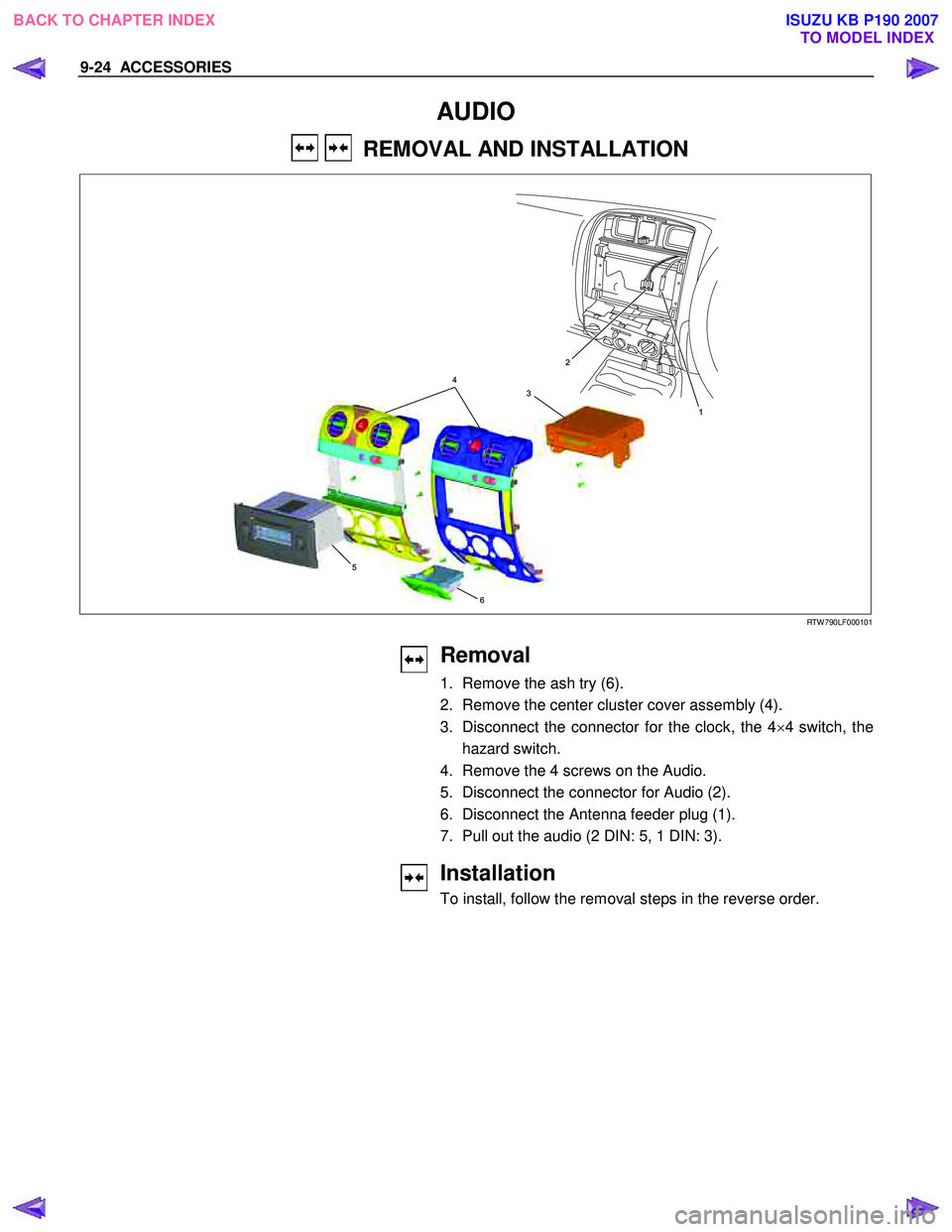
9-24 ACCESSORIES
AUDIO
REMOVAL AND INSTALLATION
1
2
4
3
5
6
RTW 790LF000101
Removal
1. Remove the ash try (6).
2. Remove the center cluster cover assembly (4).
3. Disconnect the connector for the clock, the 4 ×4 switch, the
hazard switch.
4. Remove the 4 screws on the Audio.
5. Disconnect the connector for Audio (2).
6. Disconnect the Antenna feeder plug (1).
7. Pull out the audio (2 DIN: 5, 1 DIN: 3).
Installation
To install, follow the removal steps in the reverse order.
BACK TO CHAPTER INDEX TO MODEL INDEXISUZU KB P190 2007
Page 5632 of 6020
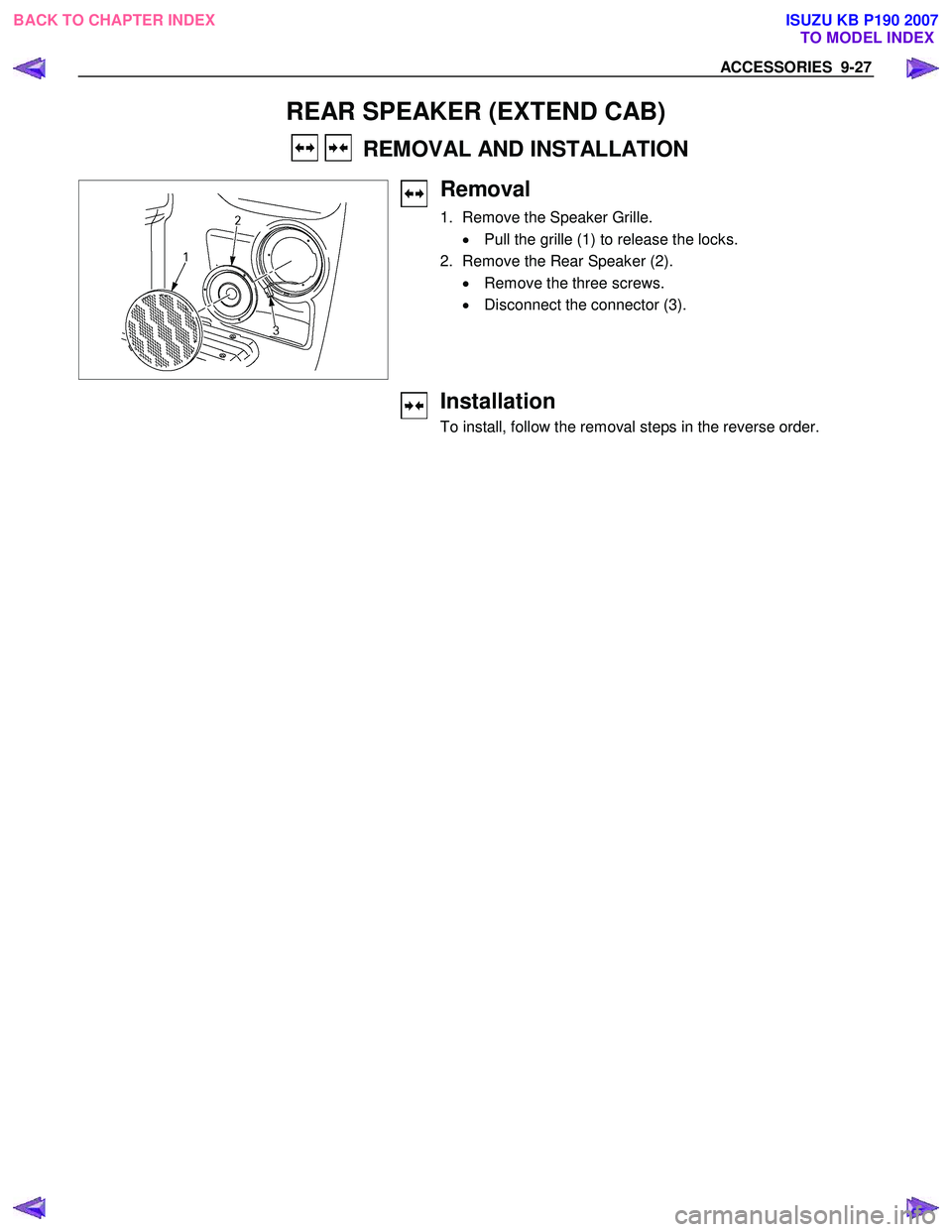
ACCESSORIES 9-27
REAR SPEAKER (EXTEND CAB)
REMOVAL AND INSTALLATION
Removal
1. Remove the Speaker Grille.
• Pull the grille (1) to release the locks.
2. Remove the Rear Speaker (2). • Remove the three screws.
• Disconnect the connector (3).
Installation
To install, follow the removal steps in the reverse order.
BACK TO CHAPTER INDEX TO MODEL INDEXISUZU KB P190 2007
Page 5634 of 6020
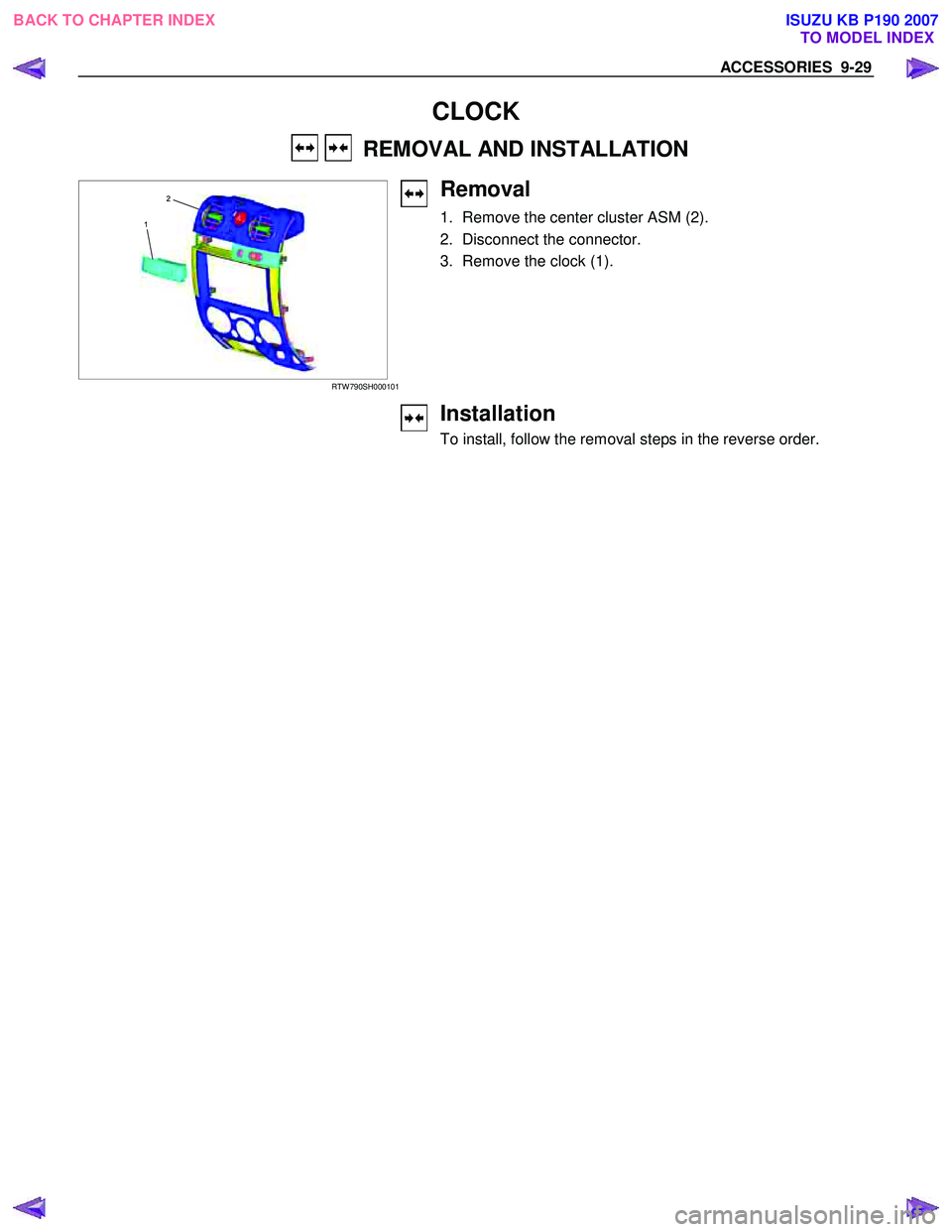
ACCESSORIES 9-29
CLOCK
REMOVAL AND INSTALLATION
1
2
RTW 790SH000101
Removal
1. Remove the center cluster ASM (2).
2. Disconnect the connector.
3. Remove the clock (1).
Installation
To install, follow the removal steps in the reverse order.
BACK TO CHAPTER INDEX TO MODEL INDEXISUZU KB P190 2007
Page 5639 of 6020
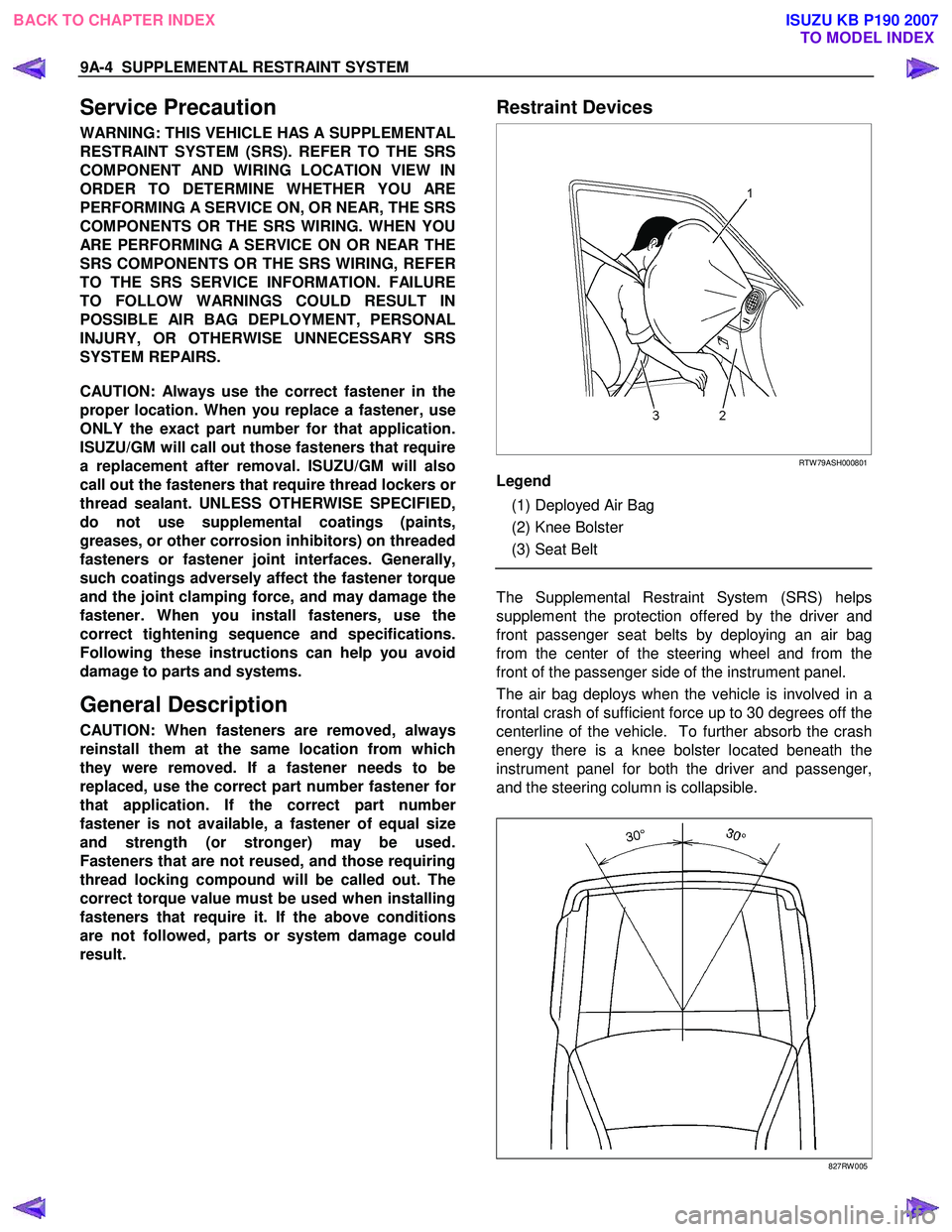
9A-4 SUPPLEMENTAL RESTRAINT SYSTEM
Service Precaution
WARNING: THIS VEHICLE HAS A SUPPLEMENTAL
RESTRAINT SYSTEM (SRS). REFER TO THE SRS
COMPONENT AND WIRING LOCATION VIEW IN
ORDER TO DETERMINE WHETHER YOU ARE
PERFORMING A SERVICE ON, OR NEAR, THE SRS
COMPONENTS OR THE SRS WIRING. WHEN YOU
ARE PERFORMING A SERVICE ON OR NEAR THE
SRS COMPONENTS OR THE SRS WIRING, REFER
TO THE SRS SERVICE INFORMATION. FAILURE
TO FOLLOW WARNINGS COULD RESULT IN
POSSIBLE AIR BAG DEPLOYMENT, PERSONAL
INJURY, OR OTHERWISE UNNECESSARY SRS
SYSTEM REPAIRS.
CAUTION: Always use the correct fastener in the
proper location. When you replace a fastener, use
ONLY the exact part number for that application.
ISUZU/GM will call out those fasteners that require
a replacement after removal. ISUZU/GM will also
call out the fasteners that require thread lockers o
r
thread sealant. UNLESS OTHERWISE SPECIFIED,
do not use supplemental coatings (paints,
greases, or other corrosion inhibitors) on threaded
fasteners or fastener joint interfaces. Generally,
such coatings adversely affect the fastener torque
and the joint clamping force, and may damage the
fastener. When you install fasteners, use the
correct tightening sequence and specifications.
Following these instructions can help you avoid
damage to parts and systems.
General Description
CAUTION: When fasteners are removed, always
reinstall them at the same location from which
they were removed. If a fastener needs to be
replaced, use the correct part number fastener fo
r
that application. If the correct part numbe
r
fastener is not available, a fastener of equal size
and strength (or stronger) may be used.
Fasteners that are not reused, and those requiring
thread locking compound will be called out. The
correct torque value must be used when installing
fasteners that require it. If the above conditions
are not followed, parts or system damage could
result.
Restraint Devices
RTW 79ASH000801
Legend
(1) Deployed Air Bag
(2) Knee Bolster
(3) Seat Belt
The Supplemental Restraint System (SRS) helps
supplement the protection offered by the driver and
front passenger seat belts by deploying an air bag
from the center of the steering wheel and from the
front of the passenger side of the instrument panel.
The air bag deploys when the vehicle is involved in a
frontal crash of sufficient force up to 30 degrees off the
centerline of the vehicle. To further absorb the crash
energy there is a knee bolster located beneath the
instrument panel for both the driver and passenger,
and the steering column is collapsible.
827RW 005
BACK TO CHAPTER INDEX TO MODEL INDEXISUZU KB P190 2007
Page 5656 of 6020
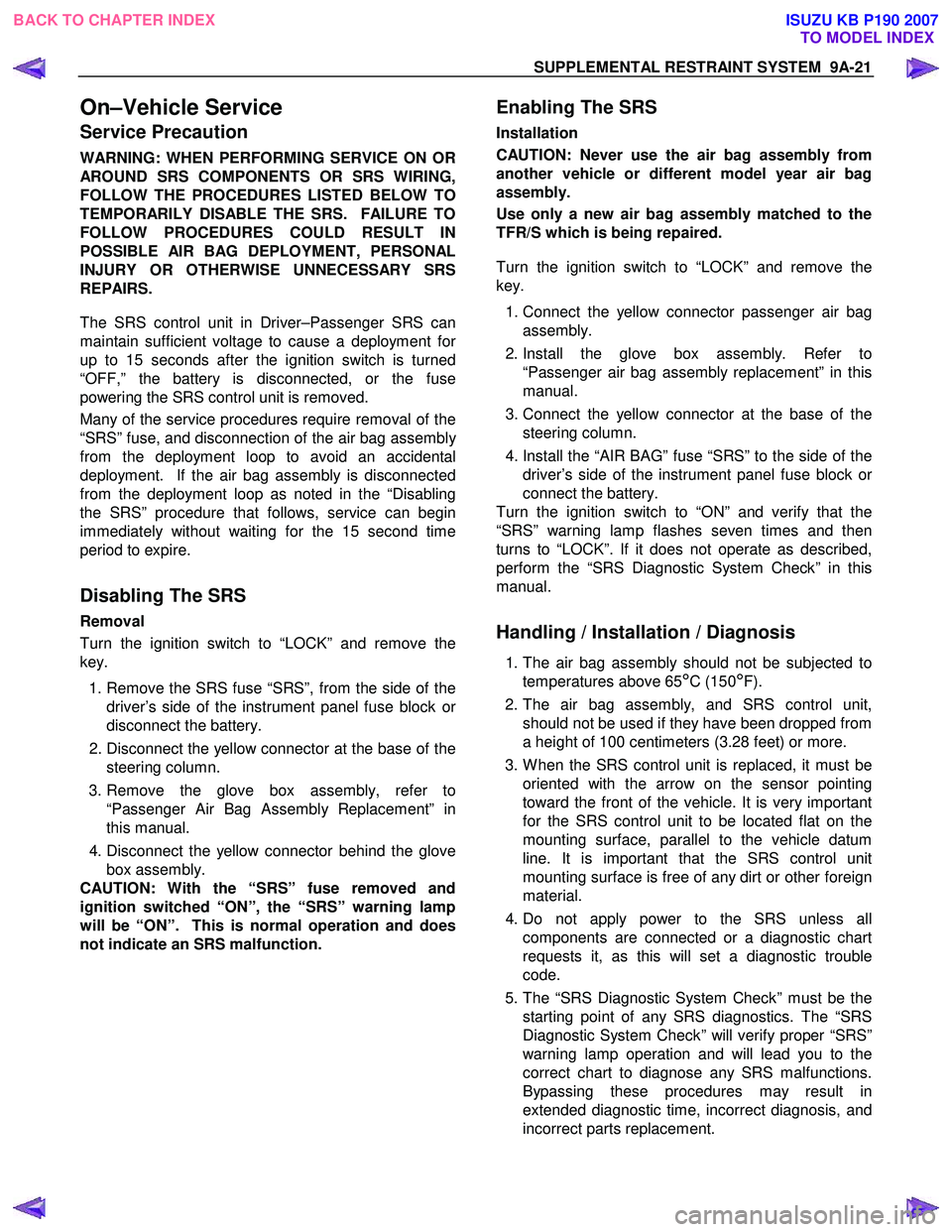
SUPPLEMENTAL RESTRAINT SYSTEM 9A-21
On–Vehicle Service
Service Precaution
WARNING: WHEN PERFORMING SERVICE ON OR
AROUND SRS COMPONENTS OR SRS WIRING,
FOLLOW THE PROCEDURES LISTED BELOW TO
TEMPORARILY DISABLE THE SRS. FAILURE TO
FOLLOW PROCEDURES COULD RESULT IN
POSSIBLE AIR BAG DEPLOYMENT, PERSONAL
INJURY OR OTHERWISE UNNECESSARY SRS
REPAIRS.
The SRS control unit in Driver–Passenger SRS can
maintain sufficient voltage to cause a deployment fo
r
up to 15 seconds after the ignition switch is turned
“OFF,” the battery is disconnected, or the fuse
powering the SRS control unit is removed.
Many of the service procedures require removal of the
“SRS” fuse, and disconnection of the air bag assembl
y
from the deployment loop to avoid an accidental
deployment. If the air bag assembly is disconnected
from the deployment loop as noted in the “Disabling
the SRS” procedure that follows, service can begin
immediately without waiting for the 15 second time
period to expire.
Disabling The SRS
Removal
Turn the ignition switch to “LOCK” and remove the
key.
1. Remove the SRS fuse “SRS”, from the side of the driver’s side of the instrument panel fuse block o
r
disconnect the battery.
2. Disconnect the yellow connector at the base of the steering column.
3. Remove the glove box assembly, refer to “Passenger Air Bag Assembly Replacement” in
this manual.
4. Disconnect the yellow connector behind the glove box assembly.
CAUTION: With the “SRS” fuse removed and
ignition switched “ON”, the “SRS” warning lamp
will be “ON”. This is normal operation and does
not indicate an SRS malfunction.
Enabling The SRS
Installation
CAUTION: Never use the air bag assembly from
another vehicle or different model year air bag
assembly.
Use only a new air bag assembly matched to the
TFR/S which is being repaired.
Turn the ignition switch to “LOCK” and remove the
key.
1. Connect the yellow connector passenger air bag assembly.
2. Install the glove box assembly. Refer to “Passenger air bag assembly replacement” in this
manual.
3. Connect the yellow connector at the base of the steering column.
4. Install the “AIR BAG” fuse “SRS” to the side of the driver’s side of the instrument panel fuse block o
r
connect the battery.
Turn the ignition switch to “ON” and verify that the
“SRS” warning lamp flashes seven times and then
turns to “LOCK”. If it does not operate as described,
perform the “SRS Diagnostic System Check” in this
manual.
Handling / Installation / Diagnosis
1. The air bag assembly should not be subjected to temperatures above 65
°C (150°F).
2. The air bag assembly, and SRS control unit, should not be used if they have been dropped from
a height of 100 centimeters (3.28 feet) or more.
3. W hen the SRS control unit is replaced, it must be oriented with the arrow on the sensor pointing
toward the front of the vehicle. It is very important
for the SRS control unit to be located flat on the
mounting surface, parallel to the vehicle datum
line. It is important that the SRS control unit
mounting surface is free of any dirt or other foreign
material.
4. Do not apply power to the SRS unless all components are connected or a diagnostic chart
requests it, as this will set a diagnostic trouble
code.
5. The “SRS Diagnostic System Check” must be the starting point of any SRS diagnostics. The “SRS
Diagnostic System Check” will verify proper “SRS”
warning lamp operation and will lead you to the
correct chart to diagnose any SRS malfunctions.
Bypassing these procedures may result in
extended diagnostic time, incorrect diagnosis, and
incorrect parts replacement.
BACK TO CHAPTER INDEX TO MODEL INDEXISUZU KB P190 2007
Page 5658 of 6020
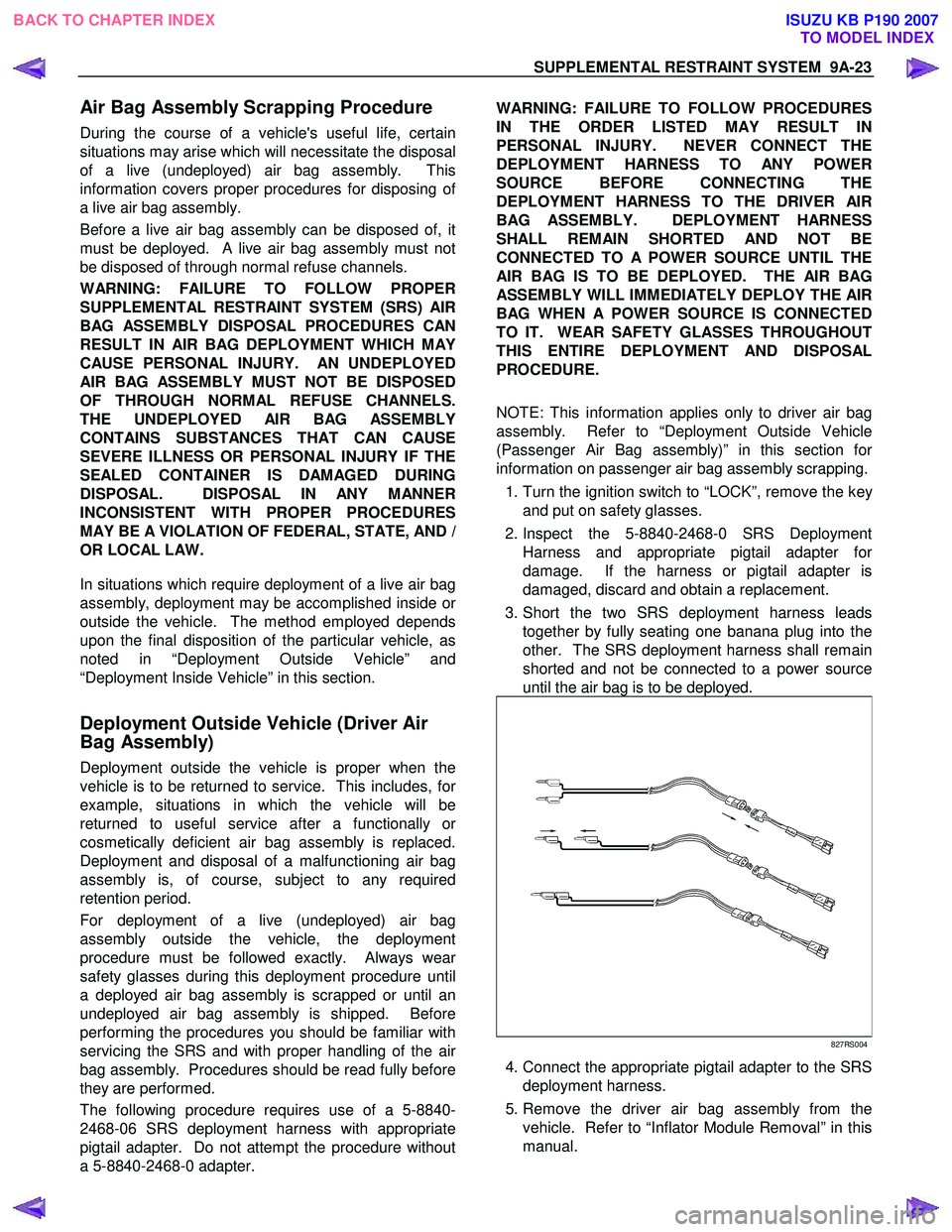
SUPPLEMENTAL RESTRAINT SYSTEM 9A-23
Air Bag Assembly Scrapping Procedure
During the course of a vehicle's useful life, certain
situations may arise which will necessitate the disposal
of a live (undeployed) air bag assembly. This
information covers proper procedures for disposing o
f
a live air bag assembly.
Before a live air bag assembly can be disposed of, it
must be deployed.
A live air bag assembly must not
be disposed of through normal refuse channels.
WARNING: FAILURE TO FOLLOW PROPER
SUPPLEMENTAL RESTRAINT SYSTEM (SRS) AIR
BAG ASSEMBLY DISPOSAL PROCEDURES CAN
RESULT IN AIR BAG DEPLOYMENT WHICH MAY
CAUSE PERSONAL INJURY. AN UNDEPLOYED
AIR BAG ASSEMBLY MUST NOT BE DISPOSED
OF THROUGH NORMAL REFUSE CHANNELS.
THE UNDEPLOYED AIR BAG ASSEMBLY
CONTAINS SUBSTANCES THAT CAN CAUSE
SEVERE ILLNESS OR PERSONAL INJURY IF THE
SEALED CONTAINER IS DAMAGED DURING
DISPOSAL. DISPOSAL IN ANY MANNER
INCONSISTENT WITH PROPER PROCEDURES
MAY BE A VIOLATION OF FEDERAL, STATE, AND
/
OR LOCAL LAW.
In situations which require deployment of a live air bag
assembly, deployment may be accomplished inside o
r
outside the vehicle. The method employed depends
upon the final disposition of the particular vehicle, as
noted in “Deployment Outside Vehicle” and
“Deployment Inside Vehicle” in this section.
Deployment Outside Vehicle (Driver Air
Bag Assembly)
Deployment outside the vehicle is proper when the
vehicle is to be returned to service. This includes, fo
r
example, situations in which the vehicle will be
returned to useful service after a functionally o
r
cosmetically deficient air bag assembly is replaced.
Deployment and disposal of a malfunctioning air bag
assembly is, of course, subject to any required
retention period.
For deployment of a live (undeployed) air bag
assembly outside the vehicle, the deployment
procedure must be followed exactly. Always wea
r
safety glasses during this deployment procedure until
a deployed air bag assembly is scrapped or until an
undeployed air bag assembly is shipped. Before
performing the procedures you should be familiar with
servicing the SRS and with proper handling of the ai
r
bag assembly. Procedures should be read fully before
they are performed.
The following procedure requires use of a 5-8840-
2468-06 SRS deployment harness with appropriate
pigtail adapter. Do not attempt the procedure without
a 5-8840-2468-0 adapter.
WARNING: F
AILURE TO FOLLOW PROCEDURES
IN THE ORDER LISTED MAY RESULT IN
PERSONAL INJURY. NEVER CONNECT THE
DEPLOYMENT HARNESS TO ANY POWER
SOURCE BEFORE CONNECTING THE
DEPLOYMENT HARNESS TO THE DRIVER AIR
BAG ASSEMBLY. DEPLOYMENT HARNESS
SHALL REMAIN SHORTED AND NOT BE
CONNECTED TO A POWER SOURCE UNTIL THE
AIR BAG IS TO BE DEPLOYED. THE AIR BAG
ASSEMBLY WILL IMMEDIATELY DEPLOY THE AIR
BAG WHEN A POWER SOURCE IS CONNECTED
TO IT. WEAR SAFETY GLASSES THROUGHOUT
THIS ENTIRE DEPLOYMENT AND DISPOSAL
PROCEDURE.
NOTE: This information applies only to driver air bag
assembly. Refer to “Deployment Outside Vehicle
(Passenger Air Bag assembly)” in this section fo
r
information on passenger air bag assembly scrapping.
1. Turn the ignition switch to “LOCK”, remove the ke
y
and put on safety glasses.
2. Inspect the 5-8840-2468-0 SRS Deployment Harness and appropriate pigtail adapter fo
r
damage. If the harness or pigtail adapter is
damaged, discard and obtain a replacement.
3. Short the two SRS deployment harness leads together by fully seating one banana plug into the
other. The SRS deployment harness shall remain
shorted and not be connected to a power source
until the air bag is to be deployed.
827RS004
4. Connect the appropriate pigtail adapter to the SRS deployment harness.
5. Remove the driver air bag assembly from the vehicle. Refer to “Inflator Module Removal” in this
manual.
BACK TO CHAPTER INDEX TO MODEL INDEXISUZU KB P190 2007
Page 5661 of 6020
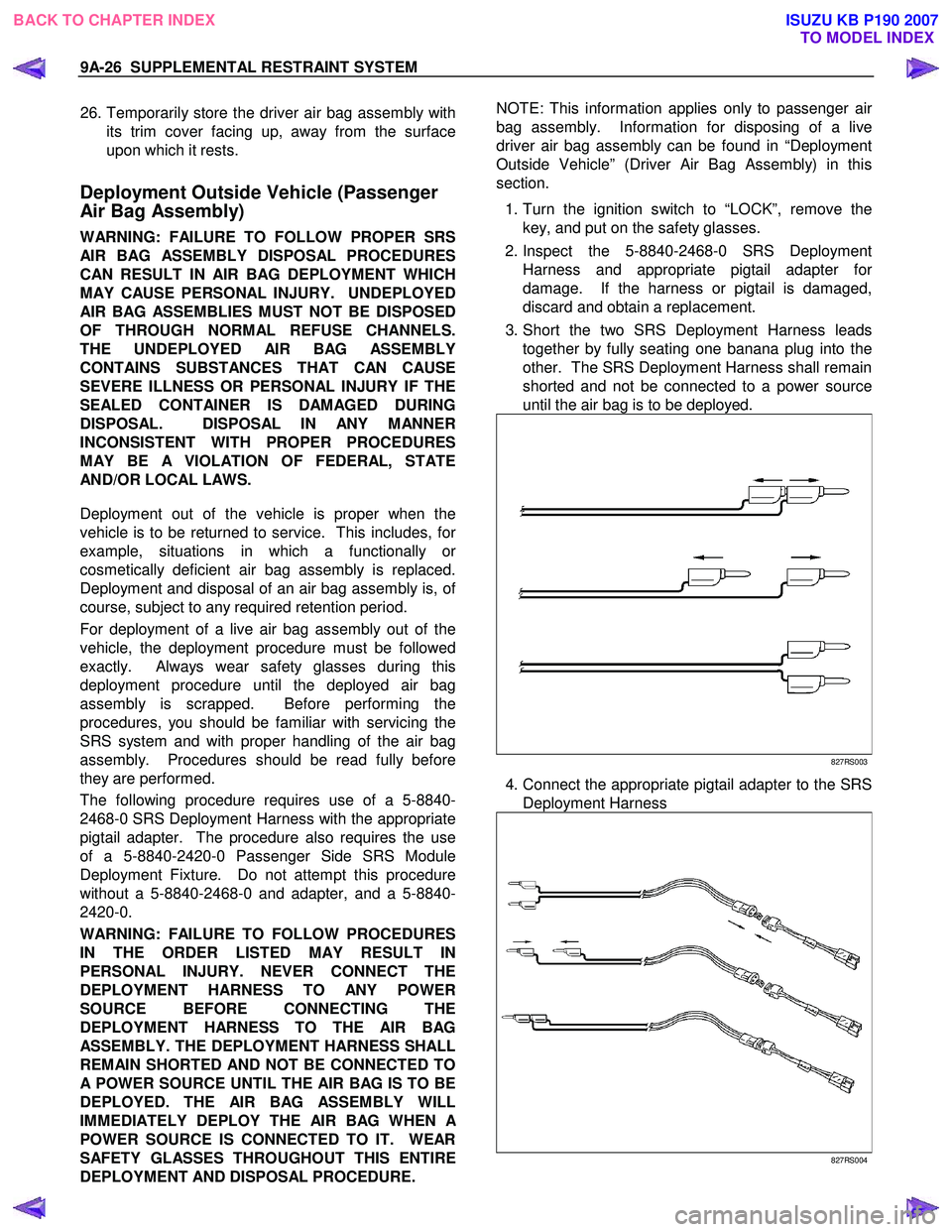
9A-26 SUPPLEMENTAL RESTRAINT SYSTEM
26. Temporarily store the driver air bag assembly with
its trim cover facing up, away from the surface
upon which it rests.
Deployment Outside Vehicle (Passenger
Air Bag Assembly)
WARNING: FAILURE TO FOLLOW PROPER SRS
AIR BAG ASSEMBLY DISPOSAL PROCEDURES
CAN RESULT IN AIR BAG DEPLOYMENT WHICH
MAY CAUSE PERSONAL INJURY. UNDEPLOYED
AIR BAG ASSEMBLIES MUST NOT BE DISPOSED
OF THROUGH NORMAL REFUSE CHANNELS.
THE UNDEPLOYED AIR BAG ASSEMBLY
CONTAINS SUBSTANCES THAT CAN CAUSE
SEVERE ILLNESS OR PERSONAL INJURY IF THE
SEALED CONTAINER IS DAMAGED DURING
DISPOSAL. DISPOSAL IN ANY MANNER
INCONSISTENT WITH PROPER PROCEDURES
MAY BE A VIOLATION OF FEDERAL, STATE
AND/OR LOCAL LAWS.
Deployment out of the vehicle is proper when the
vehicle is to be returned to service. This includes, fo
r
example, situations in which a functionally or
cosmetically deficient air bag assembly is replaced.
Deployment and disposal of an air bag assembly is, o
f
course, subject to any required retention period.
For deployment of a live air bag assembly out of the
vehicle, the deployment procedure must be followed
exactly. Always wear safety glasses during this
deployment procedure until the deployed air bag
assembly is scrapped. Before performing the
procedures, you should be familiar with servicing the
SRS system and with proper handling of the air bag
assembly. Procedures should be read fully before
they are performed.
The following procedure requires use of a 5-8840-
2468-0 SRS Deployment Harness with the appropriate
pigtail adapter. The procedure also requires the use
of a 5-8840-2420-0 Passenger Side SRS Module
Deployment Fixture. Do not attempt this procedure
without a 5-8840-2468-0 and adapter, and a 5-8840-
2420-0.
WARNING: FAILURE TO FOLLOW PROCEDURES
IN THE ORDER LISTED MA
Y RESULT IN
PERSONAL INJURY. NEVER CONNECT THE
DEPLOYMENT HARNESS TO ANY POWER
SOURCE BEFORE CONNECTING THE
DEPLOYMENT HARNESS TO THE AIR BAG
ASSEMBLY. THE DEPLOYMENT HARNESS SHALL
REMAIN SHORTED AND NOT BE CONNECTED TO
A POWER SOURCE UNTIL THE AIR BAG IS TO BE
DEPLOYED. THE AIR BAG ASSEMBLY WILL
IMMEDIATELY DEPLOY THE AIR BAG WHEN
A
POWER SOURCE IS CONNECTED TO IT. WEAR
SAFETY GLASSES THROUGHOUT THIS ENTIRE
DEPLOYMENT AND DISPOSAL PROCEDURE.
NOTE: This information applies only to passenger ai
r
bag assembly. Information for disposing of a live
driver air bag assembly can be found in “Deployment
Outside Vehicle” (Driver Air Bag Assembly) in this
section.
1. Turn the ignition switch to “LOCK”, remove the key, and put on the safety glasses.
2. Inspect the 5-8840-2468-0 SRS Deployment Harness and appropriate pigtail adapter fo
r
damage. If the harness or pigtail is damaged,
discard and obtain a replacement.
3. Short the two SRS Deployment Harness leads together by fully seating one banana plug into the
other. The SRS Deployment Harness shall remain
shorted and not be connected to a power source
until the air bag is to be deployed.
827RS003
4. Connect the appropriate pigtail adapter to the SRS Deployment Harness
827RS004
BACK TO CHAPTER INDEX TO MODEL INDEXISUZU KB P190 2007
Page 5663 of 6020
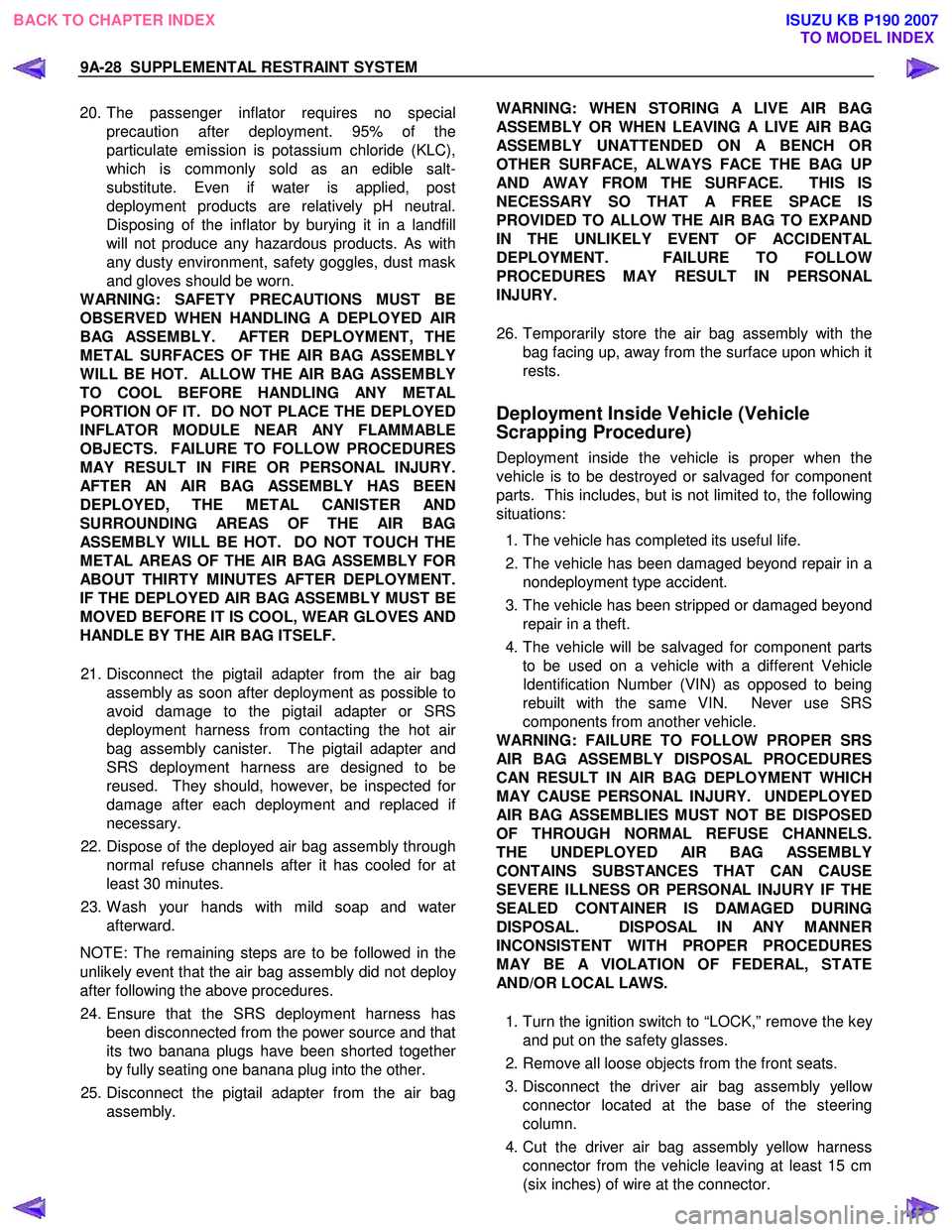
9A-28 SUPPLEMENTAL RESTRAINT SYSTEM
20. The passenger inflator requires no special
precaution after deployment. 95% of the
particulate emission is potassium chloride (KLC),
which is commonly sold as an edible salt-
substitute. Even if water is applied, post
deployment products are relatively pH neutral.
Disposing of the inflator by burying it in a landfill
will not produce any hazardous products. As with
any dusty environment, safety goggles, dust mask
and gloves should be worn.
WARNING: SAFETY PRECAUTIONS MUST BE
OBSERVED WHEN HANDLING A DEPLOYED AIR
BAG ASSEMBLY. AFTER DEPLOYMENT, THE
METAL SURFACES OF THE AIR BAG ASSEMBLY
WILL BE HOT. ALLOW THE AIR BAG ASSEMBLY
TO COOL BEFORE HANDLING ANY METAL
PORTION OF IT. DO NOT PLACE THE DEPLOYED
INFLATOR MODULE NEAR ANY FLAMMABLE
OBJECTS. FAILURE TO FOLLOW PROCEDURES
MAY RESULT IN FIRE OR PERSONAL INJURY.
AFTER AN AIR BAG ASSEMBLY HAS BEEN
DEPLOYED, THE METAL CANISTER AND
SURROUNDING AREAS OF THE AIR BAG
ASSEMBLY WILL BE HOT. DO NOT TOUCH THE
METAL AREAS OF THE AIR BAG ASSEMBLY FOR
ABOUT THIRTY MINUTES AFTER DEPLOYMENT.
IF THE DEPLOYED AIR BAG ASSEMBLY MUST BE
MOVED BEFORE IT IS COOL, WEAR GLOVES AND
HANDLE BY THE AIR BAG ITSELF.
21. Disconnect the pigtail adapter from the air bag assembly as soon after deployment as possible to
avoid damage to the pigtail adapter or SRS
deployment harness from contacting the hot ai
r
bag assembly canister. The pigtail adapter and
SRS deployment harness are designed to be
reused. They should, however, be inspected fo
r
damage after each deployment and replaced if
necessary.
22. Dispose of the deployed air bag assembly through normal refuse channels after it has cooled for at
least 30 minutes.
23. W ash your hands with mild soap and wate
r
afterward.
NOTE: The remaining steps are to be followed in the
unlikely event that the air bag assembly did not deplo
y
after following the above procedures.
24. Ensure that the SRS deployment harness has been disconnected from the power source and that
its two banana plugs have been shorted togethe
r
by fully seating one banana plug into the other.
25. Disconnect the pigtail adapter from the air bag assembly.
WARNING: WHEN STORING A LIVE AIR BAG
ASSEMBLY OR WHEN LEAVING A LIVE AIR BAG
ASSEMBLY UNATTENDED ON A BENCH OR
OTHER SURFACE, ALWAYS FACE THE BAG UP
AND AWAY FROM THE SURFACE. THIS IS
NECESSARY SO THAT A FREE SPACE IS
PROVIDED TO ALLOW THE AIR BAG TO EXPAND
IN THE UNLIKELY EVENT OF
ACCIDENTAL
DEPLOYMENT. FAILURE TO FOLLOW
PROCEDURES MAY RESULT IN PERSONAL
INJURY.
26. Temporarily store the air bag assembly with the bag facing up, away from the surface upon which it
rests.
Deployment Inside Vehicle (Vehicle
Scrapping Procedure)
Deployment inside the vehicle is proper when the
vehicle is to be destroyed or salvaged for component
parts. This includes, but is not limited to, the following
situations:
1. The vehicle has completed its useful life.
2. The vehicle has been damaged beyond repair in a nondeployment type accident.
3. The vehicle has been stripped or damaged beyond repair in a theft.
4. The vehicle will be salvaged for component parts to be used on a vehicle with a different Vehicle
Identification Number (VIN) as opposed to being
rebuilt with the same VIN. Never use SRS
components from another vehicle.
WARNING: FAILURE TO FOLLOW PROPER SRS
AIR BAG ASSEMBLY DISPOSAL PROCEDURES
CAN RESULT IN AIR BAG DEPLOYMENT WHICH
MAY CAUSE PERSONAL INJURY. UNDEPLOYED
AIR BAG ASSEMBLIES MUST NOT BE DISPOSED
OF THROUGH NORMAL REFUSE CHANNELS.
THE UNDEPLOYED AIR BAG ASSEMBLY
CONTAINS SUBSTANCES THAT CAN CAUSE
SEVERE ILLNESS OR PERSONAL INJURY IF THE
SEALED CONTAINER IS DAMAGED DURING
DISPOSAL. DISPOSAL IN ANY MANNER
INCONSISTENT WITH PROPER PROCEDURES
MAY BE A VIOLATION OF FEDERAL, STATE
AND/OR LOCAL LAWS.
1. Turn the ignition switch to “LOCK,” remove the ke
y
and put on the safety glasses.
2. Remove all loose objects from the front seats.
3. Disconnect the driver air bag assembly yello
w
connector located at the base of the steering
column.
4. Cut the driver air bag assembly yellow harness connector from the vehicle leaving at least 15 cm
(six inches) of wire at the connector.
BACK TO CHAPTER INDEX TO MODEL INDEXISUZU KB P190 2007